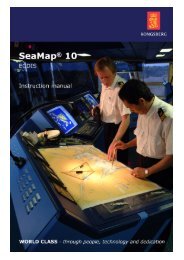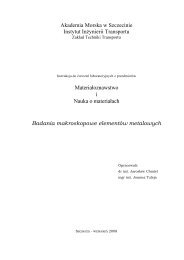- Page 1 and 2:
CARRIAGE
- Page 3 and 4:
Authors / Autorzy: Marime Universit
- Page 5 and 6:
1.6.1. Road transport . . . . . . .
- Page 8 and 9:
SPIS TREŚCI I. WSTĘP. . . . . . .
- Page 10:
4.3. Równowaga momentów wywracaj
- Page 14:
PRZEDMOWA Niestandardowe ładunki k
- Page 17 and 18:
1. South Balc Programme of Cross-bo
- Page 19 and 20:
In this connecon, aimed at the impr
- Page 21 and 22:
W Polsce współpracą transgranicz
- Page 23 and 24:
typu ładunków mają zazwyczaj wym
- Page 26 and 27:
II. OVERSIZE TRANSPORT STRATEGY FOR
- Page 28 and 29:
1.1. Polish oversize transport mark
- Page 30 and 31:
1. increase of carriage speed, 2. m
- Page 32 and 33:
France no change n/s no change no c
- Page 34 and 35:
Name Advantages (A) and disadvantag
- Page 36 and 37:
On the other hand, these new road t
- Page 38 and 39:
1.1.1.4. Oversize cargo in marime t
- Page 40 and 41:
- total length exceeds permissible
- Page 42 and 43:
transport requirements for ship’s
- Page 44 and 45:
- Freeborn has a base located at th
- Page 46 and 47:
intersecons with roads and pedestri
- Page 48 and 49:
Inland waterway class Width of the
- Page 50 and 51:
The airport in Gdańsk is character
- Page 52 and 53:
1.3.3. Inland shipping transport In
- Page 54 and 55:
the ambious goals of investment and
- Page 56 and 57:
There are several investments, conn
- Page 58 and 59:
All of the elements listed in the t
- Page 60 and 61:
1.6. Technical, organisaonal and la
- Page 62 and 63:
1.6.1.3. Law obstacles in road tran
- Page 64:
Table 17. Cargo parameters of the l
- Page 67 and 68:
Ich parametry mogą być bardzo ró
- Page 69 and 70:
Rys. 2. Transport silosów Fig.2. S
- Page 71 and 72:
Rys. 6. Przewóz plaormy wiertnicze
- Page 73 and 74:
1.1. Polski rynek przewozów ponadn
- Page 75 and 76:
Porównując rynek przewozów drogo
- Page 77 and 78:
właściwe organy państwowe lub be
- Page 79 and 80:
ujemnych efektów dopuszczenia poci
- Page 81 and 82:
8. K+P Transport Consultants, TIM C
- Page 83 and 84:
2. Wprowadzeniu Megatrailerów powi
- Page 85 and 86:
egulaminów opracowanych przez wła
- Page 87 and 88:
- ładunek wystaje poza obrys statk
- Page 89 and 90:
lub pojazdu specjalnego, których s
- Page 91 and 92:
nadania w komunikacji krajowej, a 6
- Page 93 and 94:
Rys. 14. Schemat posadowienia i moc
- Page 95 and 96:
1. C.Hartwig Szczecin, C.Hartwig Gd
- Page 97 and 98:
1.2. Charakterystyka infrastruktury
- Page 99 and 100:
- skrajnia ładunkowa, skrajnia bud
- Page 101 and 102:
Rys. 16. Istniejąca i planowana in
- Page 103 and 104:
Rys. 20. Wagon Uaais 423Z Fig. 20.
- Page 105 and 106:
104 Rys. 23. Porty morskie, śródl
- Page 107 and 108:
Dowóz/wywóz ładunków do/z portu
- Page 109 and 110:
- dużą elastycznością, - możli
- Page 111 and 112:
1.3. Statystyki dotyczące wydawany
- Page 113 and 114:
1.3.3. Transport wodny śródlądow
- Page 115 and 116:
2004 30,0 21,8 2005 30,0 20,5 2006
- Page 117 and 118:
węzłów, 150 obwodnic, buduje si
- Page 119 and 120:
Miejscem nadania lub odbioru przesy
- Page 121 and 122:
w strefie I i II. Za najbardziej at
- Page 123 and 124:
1. fundamenty z miejscowości Schwe
- Page 125 and 126:
Rys. 35. 14-osiowy pojazd do transp
- Page 127 and 128:
1.5.2. Transport kolejowy Parametry
- Page 129 and 130:
9. sieci trakcyjne, energetyczne, t
- Page 131 and 132:
wania ze strony przewoźników i sp
- Page 133 and 134:
Rys. 40. Skrajnia budowli linii zel
- Page 135 and 136:
Przykładowe ograniczenia na wybran
- Page 137 and 138:
Bardzo istotnym parametrem oprócz
- Page 139 and 140:
here: Tr - ship’s me for sailing
- Page 141 and 142:
Unified evaluaon on basis dependenc
- Page 143 and 144:
Według metody Eulera, w stałych w
- Page 145 and 146: E 1 ( ki Mj ) E (7) gdzie: M j
- Page 147 and 148: kolejowych. Prognoza do 2011 roku w
- Page 149 and 150: 3. Oversize transport map 3.1. Over
- Page 151 and 152: The technical limitaons of the road
- Page 153 and 154: 3.4.4. Law regulaons in marime tran
- Page 155 and 156: tool for preparing an applicaon for
- Page 157 and 158: that the most difficult situaon is
- Page 159 and 160: standard road traffic. Informaon of
- Page 161 and 162: 160 Rys. 47. Aktywność wiatrowa i
- Page 163 and 164: Stocznie rzeczne Maszyny Tran
- Page 165 and 166: 164 Rys. 51. Korytarz drogowy TEN-T
- Page 167 and 168: 166 Rys. 53. Korytarze transportowe
- Page 169 and 170: Rys. 55. Trasa przewozu turbiny Fig
- Page 171 and 172: 5. Rozporządzenie Ministra Infrast
- Page 173 and 174: - Prawidło 28 - określa światła
- Page 175 and 176: i wydrukowaniu powinien on zostać
- Page 177 and 178: GL, PRS etc.). Żaden statek nie mo
- Page 179 and 180: 5. sensorów ciężaru, 6. panelu i
- Page 181 and 182: The sliding of cargo will be reduce
- Page 183 and 184: 3. to award the carriers shiing the
- Page 185 and 186: 4. The principles of securing the o
- Page 187 and 188: 4. wheel-based (rolling) cargoes, 5
- Page 189 and 190: The balance of forces should be cal
- Page 191 and 192: For securing Oversize Cargoes we us
- Page 193 and 194: drivers involved in the carriage of
- Page 195: 0.7 - 1.2 m longitudinally and a ma
- Page 199 and 200: 10% LC for texle straps, 25% LC for
- Page 201 and 202: step 5 choose the larg
- Page 203 and 204: Table 32. Minimum lashing capacity
- Page 205 and 206: Table 34. Minimum lashing capacity
- Page 207 and 208: to manufacturer's data, the chain h
- Page 209 and 210: 11. Example of carriage, securing a
- Page 211 and 212: 210 m= mass of the unit a(x,y,z)= l
- Page 213 and 214: Max stress applied to drive one nut
- Page 215 and 216: 2. The force by the lashings produc
- Page 217 and 218: Ms= 2864.9 > Ft =1241.76 kNm This i
- Page 219 and 220: DESIGN OF WIRE LASHING 1 2 3 Compos
- Page 221 and 222: 7. Aer installing ,each wire will b
- Page 223 and 224: Cerficate for wire rope -Source: Si
- Page 225 and 226: Rys. 58. Masa a ciężar Fig. 58. M
- Page 227 and 228: u eksperta, wreszcie zastosowania r
- Page 229 and 230: jednak całkowicie wykluczyć, ze w
- Page 231 and 232: 230 na postoju w bezpiecznym miejsc
- Page 233 and 234: Rys. 62. Dane dotyczące podstawowy
- Page 235 and 236: 4.3. Równowaga momentów wywracaj
- Page 237 and 238: stąd, że przy takielunku ruchomym
- Page 239 and 240: ków, bez względu na miejsce ustaw
- Page 241 and 242: Rys. 70. Zasady mocowania ŁPN zapo
- Page 243 and 244: Rys. 72. Mocowanie ładunków przy
- Page 245 and 246: Rys. 74. Mocowanie liny stalowej do
- Page 247 and 248:
Rys. 77. Ciężkie skrzynie i eleme
- Page 249 and 250:
Rys. 81. Fundament silnika o cięż
- Page 251 and 252:
Rys. 85. Dodatkowe przewłoki przys
- Page 253 and 254:
7. Mocowanie ładunków ponadnormat
- Page 255 and 256:
- przyspieszeniem wzdłużnym równ
- Page 257 and 258:
uwzględniająca siły działające
- Page 259 and 260:
ładunkowej nie może się przemies
- Page 261 and 262:
W zależności od kierunku działan
- Page 263 and 264:
W sytuacji braku odpowiednich eleme
- Page 265 and 266:
Ze względu na to, że napinacz naj
- Page 267 and 268:
1. IMO/ILO/UN ECE Guidelines for Pa
- Page 269 and 270:
Tabela 30 Minimalne napięcie odci
- Page 271 and 272:
Tabela 34 Minimalne obciążenie ro
- Page 273 and 274:
8.5. Przykłady obliczania ilości
- Page 275 and 276:
9. Dziesięć najważniejszych naka
- Page 277 and 278:
276
- Page 280 and 281:
IV. CALCULATION METHODOLOGY OF CHAR
- Page 282 and 283:
Specificaon Rate in PLN per 1km 4.
- Page 284:
Calculaon PARAMETER Value Excess Co
- Page 287 and 288:
Do kosztów związanych z przystoso
- Page 289 and 290:
Wyszczególnienie Stawka opłaty w
- Page 292 and 293:
Spis rysunków Rys. 1. Rozładunek
- Page 294 and 295:
Rys. 74. Mocowanie liny stalowej do
- Page 296 and 297:
Tabela 33. Minimalne obciążenie r
- Page 298 and 299:
Bibliografia 1. Annual Report ICAO.
- Page 300 and 301:
299

















